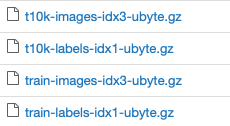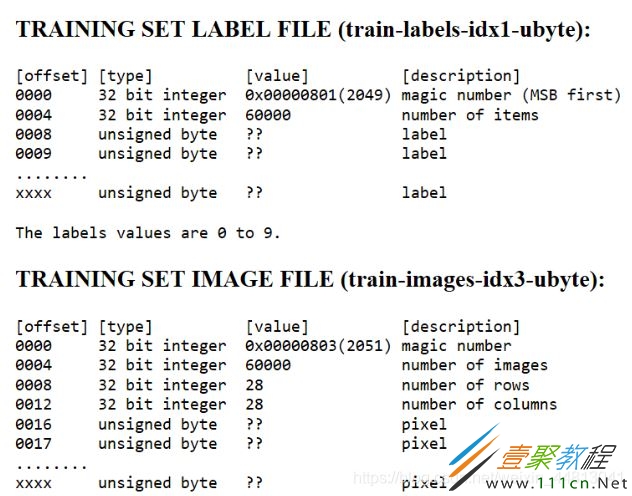python读取mnist数据集方法代码示例解析
作者:袖梨
2022-06-25
本篇文章小编给大家分享一下python读取mnist数据集方法代码示例解析,文章代码介绍的很详细,小编觉得挺不错的,现在分享给大家供大家参考,有需要的小伙伴们可以来看看。
数据集格式介绍
这部分内容网络上很常见,这里还是简明介绍一下。网络上下载的mnist数据集包含4个文件:
前两个分别是测试集的image和label,包含10000个样本。后两个是训练集的,包含60000个样本。.gz表示这个一个压缩包,如果进行解压的话,会得到.ubyte格式的二进制文件。
上图是训练集的label和image数据的存储格式。两个文件最开始都有magic number和number of images/items两个数据,有用的是第二个,表示文件中存储的样本个数。另外要注意的是数据的位数,有32位整型和8位整型两种。
读取方法
.gz格式的文件读取
需要import gzip
读取训练集的代码如下:
def load_mnist_train(path, kind='train'):
'‘'
path:数据集的路径
kind:值为train,代表读取训练集
‘'‘
labels_path = os.path.join(path,'%s-labels-idx1-ubyte.gz'% kind)
images_path = os.path.join(path,'%s-images-idx3-ubyte.gz'% kind)
#使用gzip打开文件
with gzip.open(labels_path, 'rb') as lbpath:
#使用struct.unpack方法读取前两个数据,>代表高位在前,I代表32位整型。lbpath.read(8)表示一次从文件中读取8个字节
#这样读到的前两个数据分别是magic number和样本个数
magic, n = struct.unpack('>II',lbpath.read(8))
#使用np.fromstring读取剩下的数据,lbpath.read()表示读取所有的数据
labels = np.fromstring(lbpath.read(),dtype=np.uint8)
with gzip.open(images_path, 'rb') as imgpath:
magic, num, rows, cols = struct.unpack('>IIII',imgpath.read(16))
images = np.fromstring(imgpath.read(),dtype=np.uint8).reshape(len(labels), 784)
return images, labels
读取测试集的代码类似。
非压缩文件的读取
如果在本地对四个文件解压缩之后,得到的就是.ubyte格式的文件,这时读取的代码有所变化。
def load_mnist_train(path, kind='train'):
'‘'
path:数据集的路径
kind:值为train,代表读取训练集
‘'‘
labels_path = os.path.join(path,'%s-labels-idx1-ubyte'% kind)
images_path = os.path.join(path,'%s-images-idx3-ubyte'% kind)
#不再用gzip打开文件
with open(labels_path, 'rb') as lbpath:
#使用struct.unpack方法读取前两个数据,>代表高位在前,I代表32位整型。lbpath.read(8)表示一次从文件中读取8个字节
#这样读到的前两个数据分别是magic number和样本个数
magic, n = struct.unpack('>II',lbpath.read(8))
#使用np.fromfile读取剩下的数据
labels = np.fromfile(lbpath,dtype=np.uint8)
with gzip.open(images_path, 'rb') as imgpath:
magic, num, rows, cols = struct.unpack('>IIII',imgpath.read(16))
images = np.fromfile(imgpath,dtype=np.uint8).reshape(len(labels), 784)
return images, labels
读取之后可以查看images和labels的长度,确认读取是否正确。
相关文章
精彩推荐
-
 下载
下载孢子2生物进化中文版(Spores)
模拟经营 孢子2生物进化中文版(Spores)孢子2生物进化中文版让我们来做一回疯狂的博士,打造一个属于自
-
 下载
下载叫我万岁爷九游官方版
模拟经营 叫我万岁爷九游官方版叫我万岁爷带你体验当换地点感觉,全新的模拟手游大作让你开始一
-
 下载
下载梦回凤歌
模拟经营 梦回凤歌梦回凤歌手游中你将步入古代的宫廷纷争之中,本想度过美好幸福的
-
 下载
下载洋果子店rose最新版本
模拟经营 洋果子店rose最新版本洋果子店最新版是一款十分容易让人垂涎的开店经营类手游。游戏玩
-
 下载
下载明日大亨最新版
模拟经营 明日大亨最新版明日大亨手游,一个非常经典有趣的模拟经营类型的商战手游,在游

















